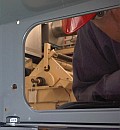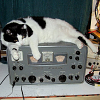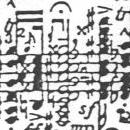I bought an Altec inductor that was pulled out of a working 260A amp:
http://cgi.ebay.com/ws/eBayISAPI.dll?ViewItem&ssPageName=STRK:MEWNX:IT&item=270367407593
I also bought an Altec filament/bias tranny that has one 120 volts, two 10 volts, one 6.3 volts, one 5 volts, and one 2.5 volts winding.
http://cgi.ebay.com/ws/eBayISAPI.dll?ViewItem&item=350182334051
I have two questions:
1) How do I measure inductance on the choke? I don't have a meter, but I do have an O-scope and a function generator. Could I use 1/C*(2pi*f)2=L if I have a known cap? How do I set it up?
2) What could I do with the bias/filament tranny? I don't know the current handling is on the 120 vac winding to decide to go for a voltage doubler. I guess I could save it for a 845 project in the distance future.
Anybody knows any DHT tubes with 10 volts heaters?
Thanks,
Min
How to measure inductance?
11 posts
• Page 1 of 1
Re: How to meaure inductance?
SDS-PAGE wrote:1) How do I measure inductance on the choke? I don't have a meter, but I do have an O-scope and a function generator. Could I use 1/C*(2pi*f)2=L if I have a known cap? How do I set it up?
That's pretty much exactly how you do it. You build a resonant circuit out of R, C, and the unknown L. Feed it a signal, and watch for the peak. Calculate L using the frequency at the peak. There's an easy to understand description of the process out there somewhere. If I can find it, it'll post the link.
This is probably enough to get you started:
http://www.thekeeser.com/Electronics%20 ... ductor.htm
"It's a different experience; the noise occlusion, crisp, clear sound, and defined powerful bass. Strong bass does not corrupt the higher frequencies, giving a very different overall feel of the sound, one that is, in my opinion, quite unique."
-

Ty_Bower - KT88
- Posts: 1494
- Joined: Wed Mar 21, 2007 2:50 pm
- Location: Newark, DE
This contraption is reasonably accurate:
http://www.angelfire.com/electronic/fun ... lyzer.html
If you want to test it without DC bias, all you need is an AC source (a filament transformer is great), a 10 ohm, 1W resistor and an accurate DMM with AC millivolts. A scope is OK too, just calculate your RMS.
Put the choke in series with the 10 ohm resistor. Apply the AC across the whole unit. Measure your RMS across your resistor. I=(E/10)/R. Make a not of this. This is your total current.
Measure your AC across the choke only (it's still in series with the resistor). Deduct the RMS across the resistor from the value you have across the choke. Calculate the AC resistance of the choke using the voltage across the choke divided by the total current you measured through the resistor: R=E/I.
Take that resistance to discover the inductance:
L [henries]= (R[choke AC resistance]/(6.28*0.00006))/1,000,000
For 50 Hz countries use L [henries]= (R[choke AC resistance]/(6.28*0.00005))/1,000,000
HTH
(I think I got this right... Ed?)
Cheers!
**edit**
The resonance method above is great for ballpark too. But use as low of frequency as you dare to keep winding capacitance from messing it up.
http://www.angelfire.com/electronic/fun ... lyzer.html
If you want to test it without DC bias, all you need is an AC source (a filament transformer is great), a 10 ohm, 1W resistor and an accurate DMM with AC millivolts. A scope is OK too, just calculate your RMS.
Put the choke in series with the 10 ohm resistor. Apply the AC across the whole unit. Measure your RMS across your resistor. I=(E/10)/R. Make a not of this. This is your total current.
Measure your AC across the choke only (it's still in series with the resistor). Deduct the RMS across the resistor from the value you have across the choke. Calculate the AC resistance of the choke using the voltage across the choke divided by the total current you measured through the resistor: R=E/I.
Take that resistance to discover the inductance:
L [henries]= (R[choke AC resistance]/(6.28*0.00006))/1,000,000
For 50 Hz countries use L [henries]= (R[choke AC resistance]/(6.28*0.00005))/1,000,000
HTH
(I think I got this right... Ed?)
Cheers!
**edit**
The resonance method above is great for ballpark too. But use as low of frequency as you dare to keep winding capacitance from messing it up.
-= Gregg =-
Fine wine comes in glass bottles, not plastic sacks. Therefore the finer electrons are also found in glass bottles.
Fine wine comes in glass bottles, not plastic sacks. Therefore the finer electrons are also found in glass bottles.
-

Geek - KT88
- Posts: 3585
- Joined: Sun Oct 21, 2007 3:01 am
- Location: Chilliwack, British Columbia
Re: How to meaure inductance?
SDS-PAGE wrote:2) What could I do with the bias/filament tranny? I don't know the current handling is on the 120 vac winding to decide to go for a voltage doubler. I guess I could save it for a 845 project in the distance future.
Anybody knows any DHT tubes with 10 volts heaters?
Thanks,
Min
211, 845, 805, 833A and the 813 in (triode mode).
-

kheper - KT88
- Posts: 1252
- Joined: Wed Dec 21, 2005 10:14 pm
- Location: Philly, PA
ELI the ICE man sez...
Since current lags the voltage (by 90 degrees, at least in theory) in an inductor (remember ELI the ICE man), you will have to add in the "trig" factors in there as well.
I'll have to dig back into the antediluvian ancient past to remember the subtleties there, something about the sum of the squires being equivalent to the square hippopotamus, or something like that...
These days, all I can remember is that a tangent is some old guy in Florida, a cosine is the other person's name on a car loan, and a vector is the opposite of a loser...
I haven't used much in the way of trigonometry in the past few decades (or any other "higher order") mathematics, for that matter. ... As they say, use it or lose it...
Yeah, the "resonance" method is probably the less complicated, as far as maths are concerned.
I got lazy, and a couple years ago, got myself a well used, but still fully, working HP LCR meter
/ed B
I'll have to dig back into the antediluvian ancient past to remember the subtleties there, something about the sum of the squires being equivalent to the square hippopotamus, or something like that...

These days, all I can remember is that a tangent is some old guy in Florida, a cosine is the other person's name on a car loan, and a vector is the opposite of a loser...
I haven't used much in the way of trigonometry in the past few decades (or any other "higher order") mathematics, for that matter. ... As they say, use it or lose it...

Yeah, the "resonance" method is probably the less complicated, as far as maths are concerned.
I got lazy, and a couple years ago, got myself a well used, but still fully, working HP LCR meter

/ed B
Real Radios Glow in the Dark
-

EWBrown - Insulator & Iron Magnate
- Posts: 6389
- Joined: Wed Mar 19, 2003 6:03 am
- Location: Now located in Clay County, NC !
If you have 60Hz power: Put a 3.75k resistor in series with the inductor. Apply 60Hz AC at some voltage (Vs) across both and measure the AC voltage across the inductor (Vl). Then the inductance is 10*Vl/Vs (within about 5%, depending). 50Hz people use 3.15k; same calculation.
This is based on the voltage divider principle and assumes that the inductor has a much larger reactance at 50/60Hz than its resistance (normally a good assumption with DC chokes and transformer primaries). The full formula (which neglects DCR) is
L = R / (2 pi f sqrt((Vs/Vl)^2 - 1)), with R the series resistance, f the frequency of the applied voltage, Vs and Vl as above.
This simplifies to L = (R Vl) / (2 pi f Vs) when Vs/Vl is large, which will take place with chokes from about 1H up.
I can go through the derivation if people want it (finally a use for my math degree!). It's only about five lines.
This is based on the voltage divider principle and assumes that the inductor has a much larger reactance at 50/60Hz than its resistance (normally a good assumption with DC chokes and transformer primaries). The full formula (which neglects DCR) is
L = R / (2 pi f sqrt((Vs/Vl)^2 - 1)), with R the series resistance, f the frequency of the applied voltage, Vs and Vl as above.
This simplifies to L = (R Vl) / (2 pi f Vs) when Vs/Vl is large, which will take place with chokes from about 1H up.
I can go through the derivation if people want it (finally a use for my math degree!). It's only about five lines.
-

jonnyeye - Posts: 109
- Joined: Thu Feb 12, 2009 3:04 pm
- Location: Sunderland, ON
As you can see SDS, like perl programming, TMTOWTDI (There's More Than One Way To Do It) 
Cheers!

Cheers!
-= Gregg =-
Fine wine comes in glass bottles, not plastic sacks. Therefore the finer electrons are also found in glass bottles.
Fine wine comes in glass bottles, not plastic sacks. Therefore the finer electrons are also found in glass bottles.
-

Geek - KT88
- Posts: 3585
- Joined: Sun Oct 21, 2007 3:01 am
- Location: Chilliwack, British Columbia
Thank you all for great information. I ended using a 3.75k resistor for measuring inductance. I didn't have one handy so I wired a bunch of resistors to get 3.78k. The inductance on the Altec turned out to be around 10H. Since that thing is around 20 lbs, I am thinking it can handle a large current. It was pulled out of Altec A260 that had PP 813s pumping out 260 watts! The amp weighs 138lbs.
I also got in the mail yesterday a Western Electric PT (860 vct 600 mA, 5VCT) that was half as big as my Heathit W-5M mono. Weighs around 28 lbs.
These will make a good 845 amp.
Min
I also got in the mail yesterday a Western Electric PT (860 vct 600 mA, 5VCT) that was half as big as my Heathit W-5M mono. Weighs around 28 lbs.
These will make a good 845 amp.
Min
-

SDS-PAGE - KT88
- Posts: 865
- Joined: Thu Feb 22, 2007 4:41 pm
- Location: Brandon, SD
More importantly, that choke should have the high voltage withstand capabi;ity for your 845 project. Most "lesser" chokes would just break down sooner or later with 900V (or higher) B+.
/ed B
/ed B
Real Radios Glow in the Dark
-

EWBrown - Insulator & Iron Magnate
- Posts: 6389
- Joined: Wed Mar 19, 2003 6:03 am
- Location: Now located in Clay County, NC !
EWBrown wrote:More importantly, that choke should have the high voltage withstand capabi;ity for your 845 project. Most "lesser" chokes would just break down sooner or later with 900V (or higher) B+.
/ed B
Or do the ham radio linear amp trick of putting the choke in the ground line of the transformer CT or bridge "-" line and put more attention to safety (make sure nothing external, input/output, etc. don't complete the circuit when you touch it)
Cheers!
-= Gregg =-
Fine wine comes in glass bottles, not plastic sacks. Therefore the finer electrons are also found in glass bottles.
Fine wine comes in glass bottles, not plastic sacks. Therefore the finer electrons are also found in glass bottles.
-

Geek - KT88
- Posts: 3585
- Joined: Sun Oct 21, 2007 3:01 am
- Location: Chilliwack, British Columbia
Anybody knows any DHT tubes with 10 volts heaters?
Here are two to start, plus one pen-toad:
211: 10V @ 3.25A
845: 10V @ 3.25A
813: 10V @ 5A (I know, it's a pentode, but it can be run in PSET or perhaps UL mode).
I'll go look for more 10V possibilities
HTH
/ed B
Real Radios Glow in the Dark
-

EWBrown - Insulator & Iron Magnate
- Posts: 6389
- Joined: Wed Mar 19, 2003 6:03 am
- Location: Now located in Clay County, NC !
11 posts
• Page 1 of 1
Who is online
Users browsing this forum: No registered users and 10 guests
